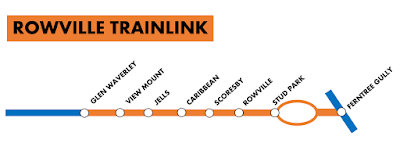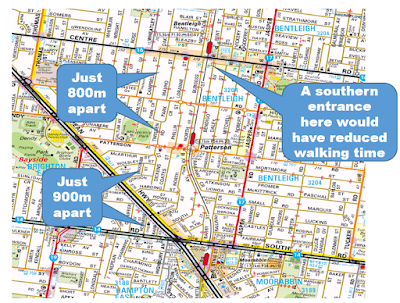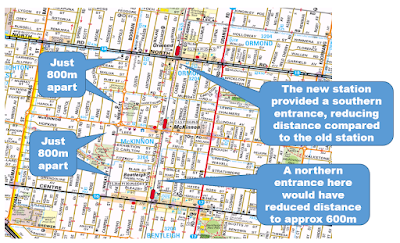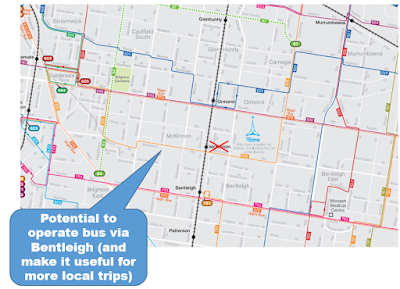Two weeks ago I
discussed the merits of a station at Keilor East to provide the proposed Melbourne Airport line with a more diverse patronage base and improve some local connections. In a nutshell it would provide some welcome patronage diversity to airport rail and bring rapid transit to a 'black hole' that, although just 15km from the Melbourne CBD, currently lacks it. Keilor East is middle-ring 1960s-70s suburbia currently represented in parliament by public transport minister Ben Carroll.
However as a station location Keilor East near Calder Freeway has shortcomings, especially if it's the only rapid transit station in the area. For example there are no major destinations nearby. And even if there was the site is horribly pedestrian hostile. This is because it is ringed by creek, railway and freeway, the latter of which can impede local access as much as facilitate through movement.
Some have suggested a station to the north east near Westfield Shoppingtown. That's a superior location with regards to land use (major shopping centre) and transport connectivity (59 tram, SmartBus and local buses). But it's out of the way for the government's proposed Airport Rail as the suggested alignment heads north well before the shopping centre. This is why it is good to consider other transport options even if we do build a station at Keilor East such as being advocated by Moonee Valley Council.
When there's a hammer every problem looks like a nail.
If there's already rail (of whatever type) it appears sensible to put passenger trains on it and use it.
The thing that the big European cities have (and even Sydney to an extent) but Melbourne lacks is fast orbital transport unhindered by cars. This is a genuine shortfall that makes the network less useful than it should be. The prevalence of radial train and tram network maps versus the scarcity of bus network maps on the system only reinforces this view.
People sometimes lament that we should have retained service on the inner and outer rail circles or had a service across the south from Oakleigh to St Kilda via the Rosstown alignment. Not unrelated was the warm reception that greeted Labor's Suburban Rail Loop proposal (despite its long time-line and massive cost).
Below I'll present two semi-fantasy options for better orbital transport serving the Airport West Shopping Centre and other places. One is rail while the other is bus rapid transit. I won't discuss cost or feasability (though pretty much everything can be done if enough money is put in). But I will comment and compare the wider network benefits of these ideas.

Option 1: Broadmeadows – Sunshine – Newport rail
Below is a concept for a second orbital Suburban Rail Loop, covering the inner-middle west on an existing rail alignment. It’s not original; similar lines would have been marked in numerous Melway street directories owned by teenage rail buffs. I make no comment about its feasibility so have branded it a fantasy concept. But people other than teenagers have suggested it, so maybe it could have legs. Click the map below for a better view.
Like what has been mooted for the Suburban Rail Loop trains would be shorter than on radial lines. They would run every 10 minutes or better with all services stopping all stations. Stations would be interchange points with radial lines or key bus routes to provide a frequent grid. Scope could exist for additional stations, such as at Brooklyn or Newport North for redeveloped denser employment and housing clusters. The bold might even suggest it as an alternative alignment of the Suburban Rail Loop west of Broadmeadows.
In other words it would be effectively a metro that would support Sunshine and Broadmeadows becoming dense Parramatta-style suburban CBD hubs. The Airport West precinct would also be boosted with good train, tram and bus access. All three would suit businesses and residents who need excellent Melbourne airport access (in conjunction with the Sunshine – Airport line). Access to Fishermans Bend could also be easy via a Melbourne Metro 2 connection. And the sort of cross-suburban access car drivers take for granted with the Western Ring Road would also become possible on public transport via this line and connecting routes.
Broadmeadows - Sunshine
Like with every concept there are cons, or at least major opportunity costs.
Much of the Broadmeadows – Sunshine alignment is hemmed in by roads, limiting local development opportunities to drive complementary land uses. A Keilor East station (technically in Airport West) could be possible on the already announced Airport line (and is advocated by Moonee Valley Council). And, in the longer term a Broadmeadows – Sunshine connection is provided for on a future Suburban Rail Loop stage. With these connections catered for, this leaves Airport West as being the only main place that would gain rail coverage if this link was completed. So would you bother?
This is an important discussion to have because when it comes to justify new rail projects there are the three Cs:
1. Coverage
2. Connectivity
3. Capacity
Coverage here is defined as access to rapid transit unhindered by cars. It won't be nearly everyone within 400m, such as can be achieved with buses on local streets, but it should be a large proportion of jobs, the main education, health and shopping facilities as well as large apartment blocks.
Connectivity comes a bit later. You might have many lines but they all go to the CBD. This severely limits the usefulness of rapid transit for other types of trips since, at best, you are reliant on slow buses. What you might call mature metro systems (eg London, Paris, Moscow Tokyo) have this type of connectivity with vastly more interchange points (especially away from the CBD) than the handful Melbourne has. The proposed Suburban Rail Loop, which is largely an orbital link between existing stations on existing radial lines, is a good example of a connectivity enhancing project. However SRL critics (eg Rail Futures which suggests an alternative plan) say that for the expenditure involved it's weak on the coverage aspect as it has only a few spots where it adds rail coverage to new locations (Monash, Deakin, Doncaster) due to wide station spacing.
Capacity also comes later. This is where usage gets so high that the existing network is overburdened. You can add some capacity with signalling upgrades or higher capacity trains. But beyond a certain point you need to add more tracks. These can either be parallel to existing tracks (just giving more capacity) or on a different alignment with some extra stations. The latter has wider network benefits as it also boosts rapid transit coverage and connectivity. The Metro Tunnel being built is a prime example as it enhances all three.
Going from abstract network planning principles to places, it's worth talking about the main ones that a Broadmeadows - Sunshine - Newport rail connection would improve access to. While not the biggest centre, Airport West Shopping Centre would see the largest access improvement if urban passenger rail was established. This is because existing transport options are either slow, infrequent or missing. That's opposed to the fast, frequent and direct that you'd want.
For example Airport West Shopping Centre currently has:
(i) a SmartBus to Broadmeadows (20 min travel time with times that don't harmonise with trains),
(ii) direct but limited hours and frequency buses to Melbourne Airport.
(iii) frequent but slow trams to the CBD via Route 59
(iv) highly variable access times to the CBD by making a 59/Craigieburn line connection at Essendon Station (with up to 20 or even 30 min waits due to the generally infrequent train service)
(v) no easy access to locations to the west or south west like Keilor East or Sunshine, with travel to the latter several times slower than driving or any future direct train.

Frequent passenger rail from Broadmeadows to Sunshine via stations at Airport West and Keilor East would obviously greatly improve connectivity in multiple directions from Airport West Shoppingtown with expected benefits for areas like Essendon Fields and Niddrie. But that's just one station. Before getting too wedded to this idea we should be open to other approaches with potentially wider benefits, as discussed later.
Sunshine - Newport
What about the Sunshine - Newport section? It traverses an industrial area and has no centre the size of Airport West Shopping Centre in the middle. It is likely to be weakly used although a boost would be expected if Melbourne Metro 2 was built.
Even without this section access to Melbourne Airport from Newport would be easy via a single change at Footscray to the proposed airport line. And there's scope to modestly speed Sunshine to Newport travel by straightening bus routes like 471.
Would surrounding areas support heavy use of a Newport - Sunshine connection? Williamstown is a heritage area unlikely to support large-scale densification. Altona isn't really a growth area either, though steady densification can be expected. While not a peninsula it is somewhat cut off from the rest of Melbourne by industry and open space. Altona's single track also limits train frequency and reliability on its line. Until that is resolved with trains able to run every 10 minutes or better you wouldn't want to be massively increasing density.
Then there’s Altona North. It’s an underserved area that really should be less remote from rail. It presents some middle-ring densification and brownfields redevelopment opportunities given that it is surrounded by dearer areas and is not that far from the CBD. Unfortunately the Newport – Sunshine line is too far east to help most of the area, even assuming a South Kingsville station.
The most promising local public transport upgrade would likely be a package comprising:
(a) the rebuilding of Paisley Station with steps direct to platform from bus stops on Millers Rd
(b) full time 7 day service from Werribee every 10 minutes via Paisley, and
(c) an upgraded SmartBus/BRT along Millers Rd interchanging with trains at Footscray, West Footscray and Paisley (done cheaply by upgrading Route 411 to SmartBus with 903 terminating at Sunshine)
(d) Closure of the poorly used Altona North Park & Ride unless required for Paisley Station parking
(e) Rejuvenation of Paisley shops as part of a precinct revival around the rebuilt station
If the decision is made now this upgrade would be doable within four years for far less expenditure than a Newport to Sunshine service.
Further west are the growth areas in the City of Wyndham and beyond there Geelong. Would they benefit from a Newport to Sunshine train? It seems less likely the further west you go. Most people can get a bus to a Geelong line train which runs directly to Sunshine rather than go indirectly via Newport.
Point Cook lacks direct trains to the Geelong line but connectivity can be improved by re-routing the 400 bus from Sunshine directly south to terminate at Williams Landing instead of Laverton. A further improvement could occur if electrified Werribee trains were extended to Wyndham Vale to permit train-train access to Sunshine, via a new station at Black Forest Rd (with a large growth area catchment).
Consequently, though they look good on a map, an orbital train from Broadmeadows to Sunshine has limited benefits, while one from Sunshine to Newport has even fewer. Especially for the growth areas of the future nearer the Geelong line. It may only be justifiable if there is also a major program of urban consolidation and development of Sunshine and Broadmeadows as much larger centres than they are now. Or if all Geelong trains revert to going via Newport. Varying opinions on this Railpage thread.

Option 2: Broadmeadows – Keilor East - Rockbank BRT
Let us supposing we still wanted to do something about east-west connectivity in the middle-north western suburbs. You might be lukewarm about the abovementioned rail option and want something that is both quicker and has some wider benefits, including to growth areas. I should mention that the Suburban Rail Loop in the area is decades away, though the airport rail will be sooner with completion by 2029.
I will assume three things:
• There is a desire for airport rail to have wider transport network benefits, with a station in the currently poorly served Keilor East area as discussed last time (and described in this Movement & Place consultants report).
• There is a desire to invest substantially in some form of improved Broadmeadows – Airport West – Sunshine link due to existing poor access. However it might not necessarily all be rail and there may be acceptance of a change of mode in exchange for wider benefits elsewhere.
• There is continued westward residential growth around Deanside with significant demand for access to local jobs in areas like Caroline Springs, Sunshine, Melbourne Airport, Airport West and Broadmeadows, along with improved feeder services for CBD commuters.
These three points have given birth to the concept network below.

Focus on the red line first. This is a bus rapid transit concept that delivers quality circumferential transport in middle suburbs and radial/feeder transit in outer (including greenfield) areas.
Stage One could be Broadmeadows Station – Airport West – Keilor East Station. It is a very direct line on the map involving buses on exclusive surface roads, elevated roads, tunnels or whatever is necessary to provide congestion free no-backtrack travel between Broadmeadows, Airport West and Keilor East Station. This section might look like busways in Brisbane and would not be cheap. Service would be every 10 minutes or better seven days per week, ie similar to proposed for Airport Rail. There would be no great coverage improvements but there would be large connectivity and travel time gains with the route forming one of several potential
fast bus wormholes around Melbourne.
Stage Two could be express to Keilor Plains station except for stops at Keilor Park and Keilor township for connections to local routes. Catchment is fairly weak around Keilor but it would provide a fast connection between the Sunbury and Craigieburn lines at the most northernmost practical point. Bus priority would not be of the heavily engineered type as found in Stage One.
Stage Three is where the route becomes more a radial rather than a circumferential route. It would operate through a mix of established then greenfield areas along Taylors Rd. It may deviate into Caroline Springs Town Centre before rejoining Taylors Rd to terminate at Rockbank Station. Again bus priority and a frequent service would operate.
The effect of this route would be to provide high quality feeder services to the Melton and Sunbury lines as well as better access to employment areas including around Watergardens, Sunshine, Melbourne Airport, Airport West and Broadmeadows. These different destinations mean that it parallels with but doesn’t compete with the train.
People are moving into these areas now but early completion would help establish the area as being more transit oriented than is common in most other growth areas. Connectivity to this route would be improved if the Sunbury line is improved to operate every 10 minutes at least as far north as Watergardens. Possibly its main disadvantage is that while it connects many lines it misses some bigger centres, requiring more changing than is desirable for some trips.
The map has some thinner lines. These would complement the Taylors Rd BRT to provide a connected network to destinations north and south. Key inclusions are service upgrades on Routes 420 and 460, the rerouting of 419 to Sunshine and a westward extension of Route 465 to Brimbank Shopping Centre. This could run either via St Albans Station (Main Road) or Sunshine Hospital/Ginifer Station (Furlong Rd).
Not shown are potential tram upgrades, including speeding up the slow 59 to Airport West (including a potential more direct route via Mt Alexander Rd) and, more radically, a 2km tram line extension (and extra route) via the Keilor Rd/Fullarton Rd alignment from Niddrie to the new Keilor East Station. Both would need Craigieburn line trains boosted to every 10 minutes all day for maximum effect including efficient interchange at Essendon.
Conclusion
Presented are two network options for a part of Melbourne that is notoriously difficult to get around on public transport for middle distance trips due to the lack of a grid provided in many northern and particularly eastern suburbs. When considered in isolation both are relatively expensive compared to what we're used to with public transport projects. On the other hand they are vastly cheaper than the Suburban Rail Loop which has redefined what can be talked about without being considered a rail nutter.
Option One involves urban metro style operation on or near a rail alignment not currently used for that. Option Two involves a bus rapid transit type service near part of that alignment before serving large growth areas to the west including Caroline Springs and Deanside.
The rail option does more for established and sometimes tired middle suburban areas, some of which may be ripe for redevelopment. Whereas the BRT concept brings good service to a larger catchment including growth areas sometimes being built at higher densities than older middle ring suburbs. Both options will involve significant capital expenditure to provide the speed and frequency required for the service to be the game changer they should be.
They have their pros and cons. Please let me know which you prefer, or whether there are other worthy possibilities (eg an Airport West - Gowanbrae - Glenroy route involving a bus-only bridge over Moonee Ponds Creek) not covered here.
See other Building Melbourne's Useful Network items here






















































